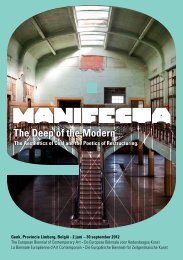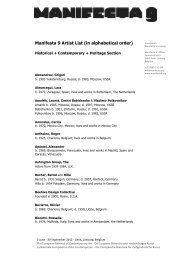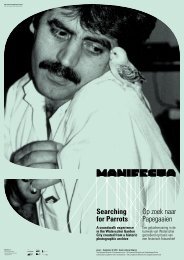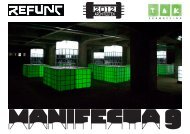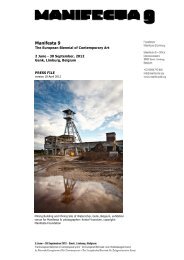informatie - Manifesta
informatie - Manifesta
informatie - Manifesta
You also want an ePaper? Increase the reach of your titles
YUMPU automatically turns print PDFs into web optimized ePapers that Google loves.
6 Waterschei, Genk, Limburg (Belgium), June–September 2012 Waterschei, Genk, Limburg (Belgium), June–September 2012<br />
7<br />
Cuauhtémoc Medina<br />
<strong>Manifesta</strong> 9:<br />
The Deep of the<br />
Modern<br />
In the summer of 2010 I was one of three shortlisted candidates competing for the<br />
position of Curator of <strong>Manifesta</strong> 9. Exploring Genk and Limburg in search of a possible<br />
agenda for the organization of my project, I fell under the spell of the extraordinary<br />
texture of the industrial history of the coalfield region. Not only was I amazed at the<br />
visible traces of coalmining, the industry which had laid the foundation of the society<br />
and the territory, but in the slagheaps, city gardens, and also the people and their<br />
memories, I had a chance to witness a specific instance of a peculiar cultural anxiety<br />
about the way mining’s past could be both preserved and overcome, retained and<br />
carried forward into the future. Visiting former mine sites in Limburg and meeting<br />
the local organizations and individuals trying to preserve the memory and heritage of<br />
the Campine coal region made me feel the urgency of questioning the relationship<br />
between contemporary artistic practice and the consciousness of the historicity of<br />
capitalist modernization. The rift between the extraordinary energy of memory among<br />
the former miners and advocates of a culture of heritage, and the local establishment’s<br />
pursuit of a new economic and social destiny for Limburg made me acutely aware of<br />
the fragility of the relationship between the past and the present in the outlook and<br />
institutions of post-industrial societies.<br />
In an especially compelling way—though not unlike other locations of this paradoxical<br />
condition we call modernity—Genk seemed to me to be symptomatic of a cultural neurosis<br />
that I would describe as a fear of nostalgia. Certainly, the violence of capitalist<br />
modernization and the unsettling process of sudden, uneven and discontinuous social<br />
changes it brings about in different parts of the world have produced troubling forms<br />
of political and social nostalgia. The worst and most hysterical of these is the violent<br />
wish to restore an idealized and nonexistent past that has been irrevocably lost to the<br />
extension of global capitalism: phenomena such as so-called religious fundamentalism<br />
and Right Wing identity politics depend to a certain extent on the utopian fantasy of<br />
returning to an imaginary time of simplicity, homogeneity and order. Without forgetting<br />
that, under certain conditions, such sentiments can and do give rise to suicide<br />
bombers, diverse forms of racism and identity politics, my impression was that the<br />
Cuauhtémoc Medina<br />
<strong>Manifesta</strong> 9:<br />
The Deep of the Modern<br />
Tijdens de zomer van 2010 was ik een van de drie<br />
kandidaten die waren geselecteerd voor de functie<br />
van curator van <strong>Manifesta</strong> 9. Terwijl ik Genk en<br />
Limburg verkende, op zoek naar een mogelijke<br />
insteek voor het uitwerken van mijn project, was ik<br />
verbaasd over de uitzonderlijke samenhang van de<br />
industriële geschiedenis van het steenkoolgebied.<br />
Ik stond niet alleen versteld van de zichtbare sporen<br />
van de mijnindustrie die aan de basis lag van de<br />
gehele samenleving in de regio. Ook in de terrils, de<br />
tuinwijken en bij de mensen en hun herinneringen,<br />
kon ik een glimp opvangen van een eigenaardige<br />
angst over hoe het mijnverleden niet alleen bewaard<br />
maar ook overwonnen kon worden; hoe het niet<br />
alleen behouden kon blijven maar ook voortgezet kon<br />
worden in de toekomst. Terwijl ik oude mijnsites in<br />
Limburg bezocht en de lokale organisaties en personen<br />
ontmoette die de herinnering en het erfgoed van<br />
de Kempense mijnstreek willen bewaren, voelde ik<br />
de behoefte om de relatie tussen de hedendaagse<br />
kunstproductie en het bewustzijn van de historiciteit<br />
van de kapitalistische modernisatie in vraag te<br />
stellen. De kloof tussen de buitengewone kracht van<br />
herinneringen bij ex-mijnwerkers en voorstanders<br />
van een erfgoedcultuur en het streven van de<br />
lokale autoriteiten naar een nieuwe economische<br />
en sociale bestemming voor Limburg, toonde me<br />
duidelijk hoe fragiel de relatie is tussen heden<br />
en verleden, bezien vanuit het perspectief van de<br />
postindustriële maatschappij en haar instituties. Op<br />
een uiterst dwingende manier – hoewel niet anders<br />
dan andere locaties in deze paradoxale toestand die<br />
we moderniteit noemen – leek Genk te lijden onder<br />
een culturele neurose die ik zou omschrijven als een<br />
vrees voor nostalgie. Uiteraard hebben het geweld<br />
van de kapitalistische modernisatie en het grillige<br />
proces van plotse, ongelijke en fragmentarische sociale<br />
veranderingen die in verschillende delen van de<br />
wereld werden veroorzaakt, problematische vormen<br />
van politieke en sociale nostalgie voortgebracht. De<br />
ergste en meest hysterische vorm van nostalgie is de<br />
vurige wens om een geïdealiseerd en niet-bestaand<br />
verleden terug te brengen dat onherroepelijk verloren<br />
is gegaan door de uitbreiding van het globale<br />
kapitalisme: fenomenen zoals religieus fundamentalisme<br />
en rechtse politiek zijn deels afhankelijk van de<br />
utopische illusie terug te keren naar een denkbeeldige<br />
tijd van eenvoud, homogeniteit en orde. Zonder<br />
past frequently shows up as an undefined apparition preventing what different elites<br />
and social discourses tend to describe as the pursuit or design of a different future.<br />
It seems to me that many contemporary agents tend to believe – often for no reason<br />
– that cavorting with the past entails a risk of falling into some sort of demonic possession,<br />
or that an excessive interaction with memory would somehow hinder the ability<br />
of citizen, consumer and producer to engage in the next phase of development. It is as<br />
if resistance to the violent policies of modernization were the result of an enthrallment<br />
with the past rather than of a distrust stemming from a more or less rational experience<br />
of the unfulfilled promises of the neoliberal ideologies of the last decades.<br />
How could a biennial exhibition serving practices apparently committed to the selfreflexivity<br />
of the present contribute to an expanded exploration of the cultural tensions<br />
involved in the process of industrial modernization? And how would it be able to<br />
answer the call of the specificity of a social milieu such as Genk, where the tension<br />
between different phases of industrial civilization are so acutely apparent to foreigner<br />
and local observers alike? Such an appeal defined the need to question the role of<br />
biennials as tools for a certain social mapping, to question how to intervene in the gap<br />
between the pursuit of social memory and the desire for modernization. <strong>Manifesta</strong> 9:<br />
The Deep of the Modern aims to demonstrate that cultural and artistic engagement<br />
with the historical conditions of production has nothing to do with nostalgia: that<br />
in fact, it has more to do with a creative field of aesthetic, sensory and intellectual<br />
responses to the constant revolutionizing of life that accompanies industrial modernity,<br />
always too rich and complex to be reduced to a simple opposition between nostalgia<br />
and the flight toward a new social formation.<br />
te vergeten dat zulke gevoelens onder bepaalde<br />
omstandigheden kunnen, en zullen leiden tot zelfmoordbomaanslagen,<br />
diverse vormen van racisme en<br />
identiteitspolitiek, heb ik de indruk dat het verleden<br />
vaak opduikt als een vage verschijning die verhindert<br />
wat verschillende elites en sociale discoursen graag<br />
omschrijven als het nastreven of ontwerpen van een<br />
andere toekomst. Mij lijkt het alsof veel hedendaagse<br />
vertegenwoordigers graag geloven – vaak zonder<br />
reden – dat je door te jongleren met het verleden<br />
riskeert in een soort demonische bezetenheid te<br />
komen, of dat een buitensporige interactie met het<br />
geheugen het vermogen van burger, consument en<br />
producent zou aantasten om in de volgende fase van<br />
ontwikkeling te treden. Het lijkt alsof de weerstand<br />
tegen de gewelddadige politiek van de modernisatie<br />
eerder het resultaat is van een fascinatie voor<br />
het verleden dan van een wantrouwen afkomstig<br />
van een min of meer rationele beleving van de<br />
onvervulde beloften van de neoliberale ideologieën<br />
van de laatste decennia. Hoe kan een biënnale met<br />
een aanpak die schijnbaar de zelf-reflexiviteit van het<br />
heden in de hand werkt, bijdragen aan een ruimere<br />
verkenning van de culturele spanningen eigen aan<br />
het proces van de industriële modernisatie? Hoe kan<br />
een biënnale voldoen aan de eis van een specifiek<br />
sociaal milieu zoals Genk, waar de spanning tussen<br />
verschillende fasen van industriële beschaving zich<br />
zo scherp aftekent voor zowel buitenlanders als<br />
lokale bezoekers? Een dergelijke eis creëerde de<br />
behoefte om de rol van biënnales als tool om een<br />
soort sociale kaart uit te tekenen, te betwijfelen, en<br />
ons af te vragen hoe om te gaan met de kloof tussen<br />
het nastreven van het sociaal geheugen en het verlangen<br />
naar modernisatie. <strong>Manifesta</strong> 9: The Deep of<br />
the Modern wil aantonen dat culturele en artistieke<br />
betrokkenheid bij de historische omstandigheden van<br />
productie niets te maken heeft met nostalgie: dat het<br />
in feite meer te maken heeft met een creatief veld<br />
van esthetische, zintuiglijke en intellectuele reacties<br />
op het constant veranderen van het leven dat gepaard<br />
gaat met de industriële moderniteit, doorgaans<br />
te breed en complex om te worden teruggebracht tot<br />
een eenvoudige tegenstelling tussen nostalgie en de<br />
vlucht naar een nieuwe sociale formatie.<br />
Het concept<br />
Met The Deep of the Modern willen we een complexe<br />
dialoog creëren tussen verschillende lagen<br />
van kunst, erfgoed en geschiedenis. Het vertrekpunt<br />
is de geografische locatie zelf, de voormalige<br />
mijnstreek van de Kempen in het noordoosten van<br />
België – een plaats voor verschillende imaginaire<br />
en ecologische kwesties die te maken hebben met<br />
het industriële kapitalisme als wereldomvattend<br />
fenomeen. <strong>Manifesta</strong> 9 zoekt zijn inspiratie in het<br />
voormalige mijncomplex van Waterschei in Genk,<br />
waarvan de gebouwen onlangs gerestaureerd zijn.<br />
Die site is meteen ook de belangrijkste locatie van<br />
<strong>Manifesta</strong> 9. De plek is een onderdeel van een allesomvattende<br />
geografische/ecologische “mijnmachine,”<br />
(Peter Bongaerts) een landschap dat bestaat<br />
uit veellagige combinaties van tuinsteden, stedelijke<br />
planning, fabrieken, kanalen, wegen en spoorwegen,<br />
in de loop van de twintigste eeuw gebouwd voor de<br />
steenkoolindustrie.<br />
The Deep of the Modern bestaat uit drie delen:<br />
hedendaagse werken, iconen van de kunstgeschiedenis<br />
die specifiek geïnspireerd zijn door het thema<br />
The Concept<br />
The Deep of the Modern intends to create a complex<br />
dialogue between different layers of art, heritage<br />
and history. Its point of departure is the geographical<br />
location itself, the former coalmining region of the<br />
Campine in northeastern Belgium. A locus for different<br />
imaginary and ecological issues aligned to industrial<br />
capitalism as a global phenomenon. <strong>Manifesta</strong> 9<br />
takes its cue from the previously abandoned, recently<br />
restored Waterschei mine complex in Genk, Limburg,<br />
which is the main venue of <strong>Manifesta</strong> 9. It is part of<br />
an all-encompassing geographic/ecological “mining<br />
machine,” (Peter Bongaerts) a landscape made up<br />
from the multi-layered combinations of garden cities,<br />
urban planning, factories, canals, roads and railroads<br />
built to serve the coal-mining industry throughout the<br />
twentieth century.<br />
The Deep of the Modern has been developed in<br />
three sections: contemporary works, icons of art<br />
steenkool of door de invloed van steenkool in brede<br />
zin, en ten slotte een reeks tentoonstellingen die het<br />
erfgoed van de steenkoolontginning verkennen. Op<br />
het kritische vlak poneert The Deep of the Modern<br />
dat kunstproductie en historische kennis inherente<br />
verantwoordelijkheden impliceren wat betreft<br />
esthetiek, het nadenken over de maatschappij en de<br />
verhoudingen tussen de verschillende generaties. In<br />
die zin moedigt de tentoonstelling het publiek aan<br />
om zorgvuldig na te denken over de kunstwerken,<br />
beelden, historische <strong>informatie</strong> en culturele instellingen,<br />
en over hoe deze de moderne en postindustriële<br />
manieren van denken kunnen beïnvloeden.<br />
<strong>Manifesta</strong> 9 verkent hoe kunst en cultuur essentieel<br />
zijn voor de manier waarop maatschappelijke<br />
processen het uiterlijke voorkomen van specifieke<br />
maatschappelijke groepen kunnen registreren<br />
en transformeren. Via verschillende poëtische<br />
benaderingen en manieren van uitbeelden, creëert<br />
<strong>Manifesta</strong> 9 de middelen voor een beter begrip van<br />
maatschappij en geschiedenis.<br />
history specifically inspired by the coal or its broader<br />
influence, and a series of exhibitions tracing the coalmining<br />
heritage of the region. At a critical level, The<br />
Deep of the Modern maintains that art production and<br />
historical knowledge have inborn responsibilities in<br />
terms of aesthetics, social reflection and relationships<br />
between different generations. In this sense, the<br />
exhibition encourages the viewer to become involved<br />
in the careful consideration of artworks, images, historical<br />
information and cultural institutions, and how<br />
these might affect modern and post-industrial ways of<br />
thinking. This event investigates how art and culture<br />
are essential to the way social processes can both<br />
record and transform the outlook of specific groups<br />
in society. Using different poetic approaches and<br />
methods of representation, <strong>Manifesta</strong> 9 provides the<br />
means for greater social and historical understanding.<br />
The Deep of the Modern ontwikkelt zich als een<br />
dialoog tussen drie verschillende onderdelen.<br />
1. De poëzie van de herstructurering: hedendaagse<br />
kunst.<br />
Een selectie van artistieke antwoorden (39 in totaal)<br />
op de wereldwijde veranderingen in het productiesysteem.<br />
2. Het tijdperk van de steenkool: het kunsthistorische<br />
luik<br />
Een selectie van kunstwerken daterend van de<br />
negentiende tot de vroege eenentwintigste eeuw<br />
die zich bezinnen op de diepgaande invloed van<br />
steenkool – als de belangrijkste bron van energie<br />
tijdens de industriële revolutie – op de geschiedenis<br />
van de moderne kunst.<br />
3. 17 Ton: Het erfgoedluik<br />
17 Ton verkent de culturele productie die ontstond in<br />
Europa na de mijnsluitingen in de tweede helft van<br />
de twintigste eeuw.<br />
The Deep of the Modern has been developed as a<br />
dialogue between three different sections.<br />
1. Poetics of Restructuring: Contemporary Art<br />
A selection of artistic responses (39 artists in total) to<br />
the changes incurred to the production system around<br />
the world.<br />
2. The Age of Coal: The Art Historical Section<br />
A selection of artworks from the nineteenth to the<br />
early twenty-first century reflecting on the profound<br />
influence of coal, as the main source of energy during<br />
the Industrial Revolution, on the history of modern art.<br />
3. 17 Tons: The Heritage Section<br />
17 Tons investigates the cultural production that<br />
sprang up in Europe after the closure of the mines in<br />
the second half of the twentieth century.<br />
<strong>Manifesta</strong> 9<br />
Chief Curator<br />
Cuauhtémoc Medina<br />
Photo: Kristof Vrancken<br />
Cuauhtémoc Medina (Mexico), criticus, curator<br />
en kunsthistoricus met een Ph D in geschiedenis en<br />
kunsttheorie (University of Essex, VK) en een diploma<br />
geschiedenis (Universidad Autónoma de México). Hij<br />
is onderzoeker aan het Instituto de Investigaciones<br />
Estéticas verbonden aan de Universidad Nacional<br />
Autónoma de México. Van 2002 tot 2008 was hij<br />
hoofdcurator van de Latijns-Amerikaanse kunstcollecties<br />
in het Tate Modern. Medina was onder<br />
andere curator voor evenementen en tentoonstellingen<br />
als Cuando la fe mueve montañas van Francis<br />
Alÿs (Lima, Peru, 2001), 20 Million Mexicans Can’t<br />
Be Wrong (South London Gallery, 2002), La era de<br />
la discrepancia. Arte y Cultura Visual en México<br />
(1968-1997) (medecurator, andere curatoren waren<br />
Olivier Debroise, Pilar García en Alvaro Vazquez,<br />
2007-2008). In 2009 was hij curator van ¿De qué<br />
otra cosa podríamos hablar?, het project dat Teresa<br />
Margolles voorstelde in het Mexicaanse paviljoen<br />
op de Biënnale van Venetië. Hij organiseerde ook<br />
Dominó Caníbal, een tentoonstelling in het kader van<br />
het Spaanse kunstproject PAC Murcia die liep van<br />
januari tot december 2010.<br />
Cuauhtémoc Medina (Mexico), critic, curator and<br />
art historian. Doctor in History and Theory of Art<br />
(PhD) from the University of Essex, UK, and a degree<br />
in History from Universidad Nacional Autónoma. He<br />
is a research fellow at Instituto de Investigaciones<br />
Estéticas at Universidad Nacional Autónoma de<br />
México. Between 2002 and 2008 he was the first<br />
Associate Curator of Latin American Art in the<br />
collections of Tate Modern. Medina has curated,<br />
among others, events and exhibitions like Cuando la<br />
fe mueve montañas dedicated to Francis Alÿs (Lima,<br />
Peru, 2001), 20 Million Mexicans Can’t Be Wrong<br />
(South London Gallery, 2002), La era de la discrepancia.<br />
Arte y Cultura Visual en México (1968–1997)<br />
(co-curated with Olivier Debroise, Pilar García &<br />
Álvaro Vázquez, 2007-2008). In 2009 he curated ¿De<br />
qué otra cosa podríamos hablar?, the project Teresa<br />
Margolles presented at the Mexican Pavilion of<br />
the Venice Biennale. In 2010 he organized Dominó<br />
Caníbal, a year-long exhibition for PAC Murcia, Spain.




